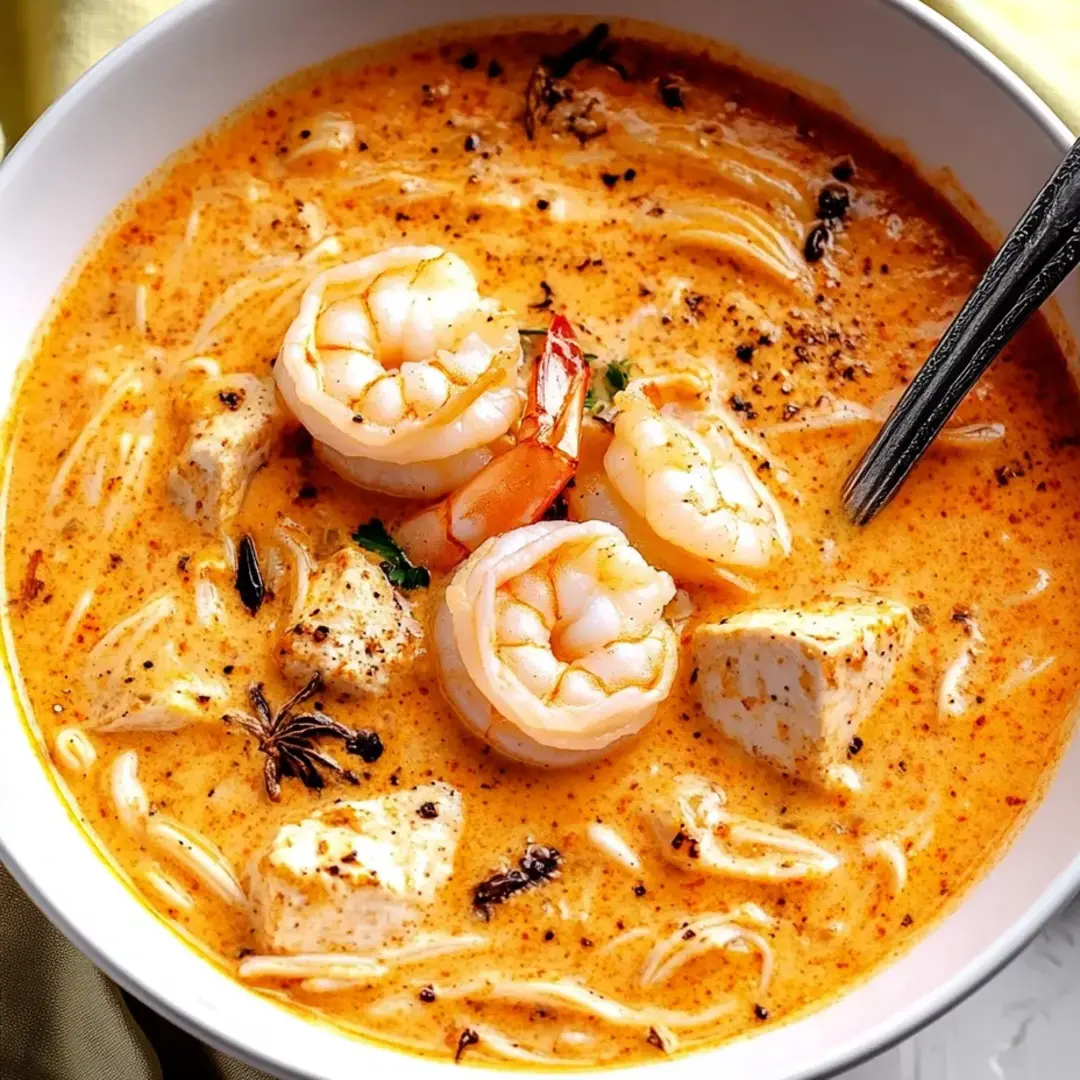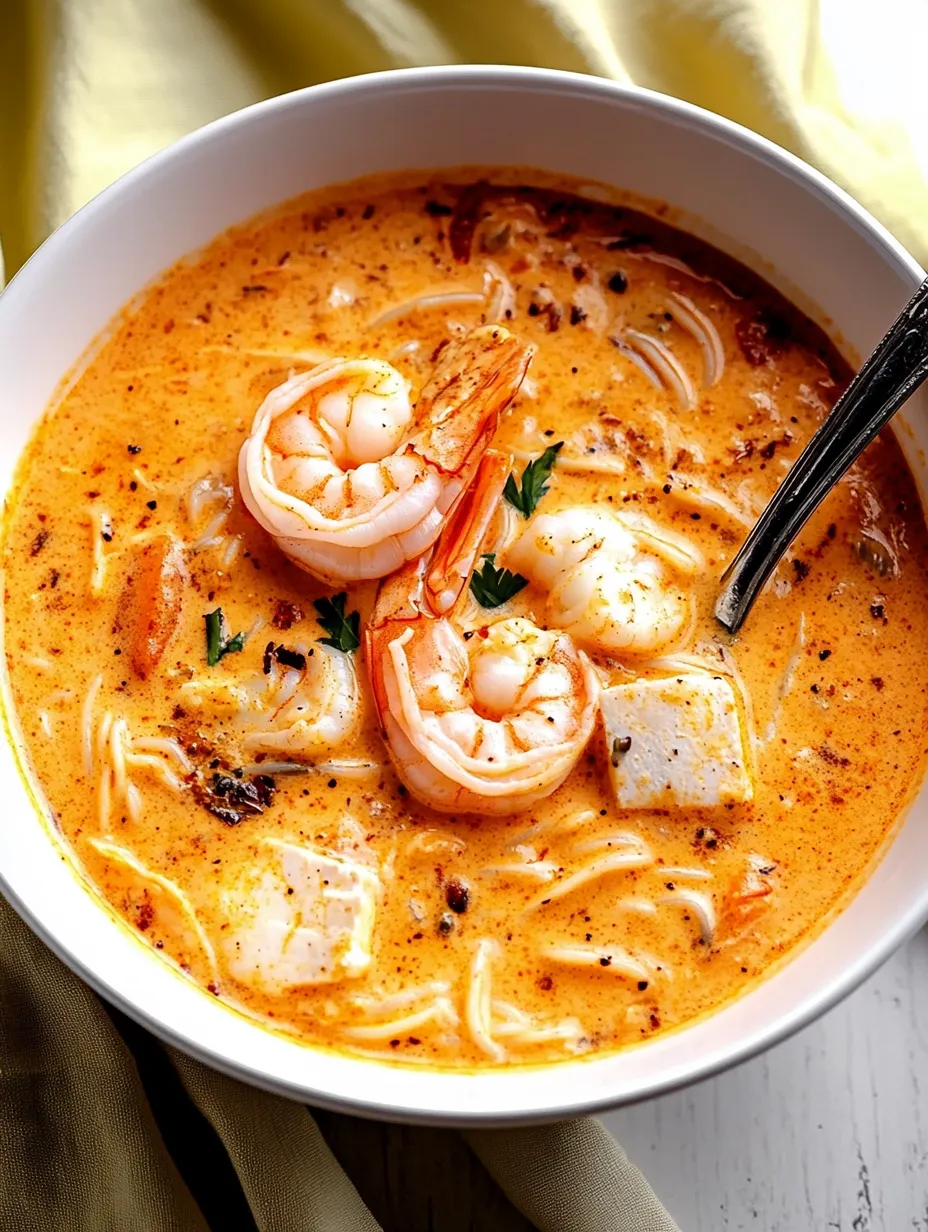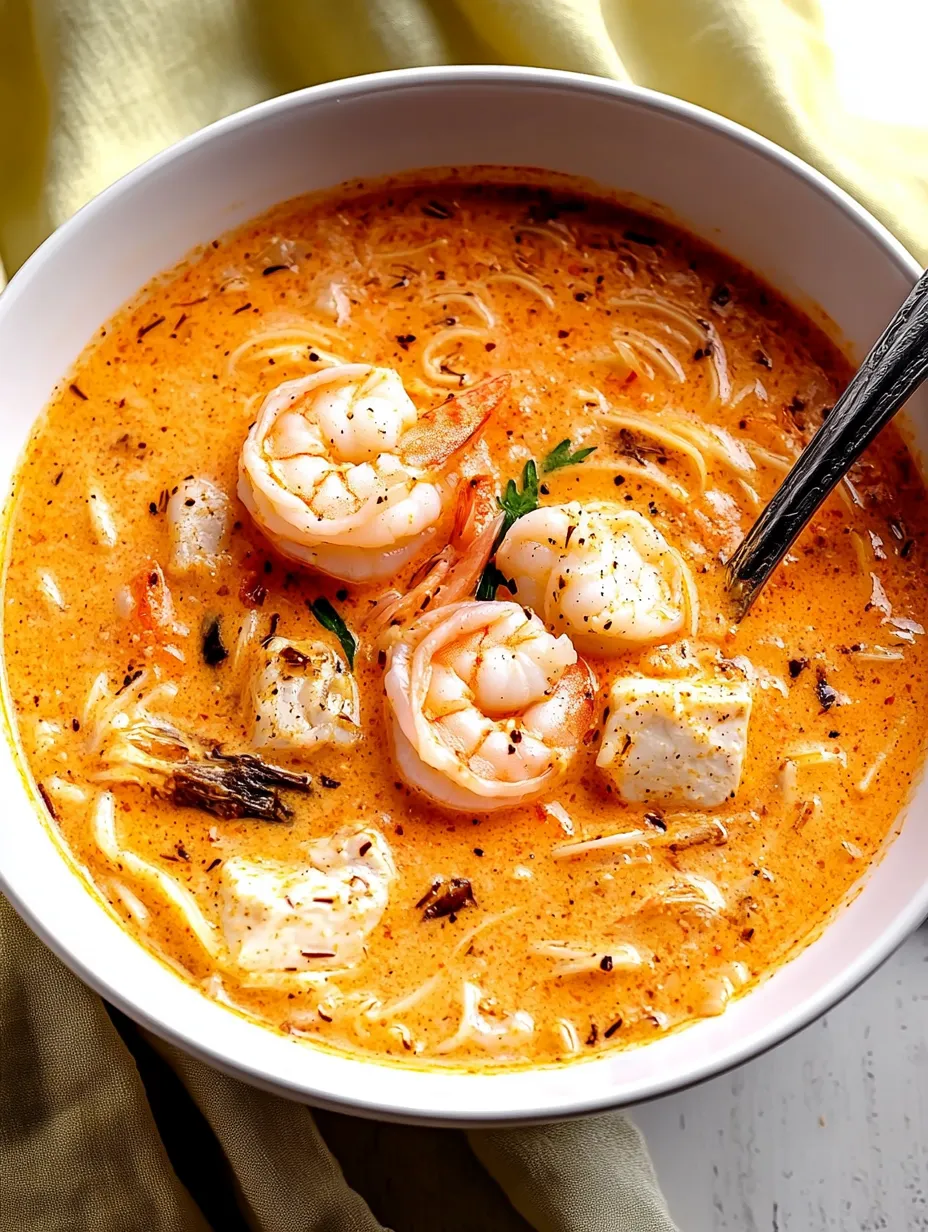 Pin it
Pin it
This Peruvian shrimp soup (chupe de camarones) transforms simple ingredients into a luxuriously creamy, flavor-packed meal that feels both comforting and special. Each spoonful delivers tender chunks of shrimp in a rich broth, punctuated by melting pockets of feta cheese and delicate strands of pasta. What makes this soup truly extraordinary is the homemade shrimp stock created from the shells – an easy but crucial step that infuses the entire dish with intense seafood flavor. Unlike more complex versions with multiple starches, this streamlined recipe focuses on the essentials, allowing the shrimp and feta to take center stage for a memorable meal that comes together with surprising ease.
I treasure this soup because it connects me directly to my Peruvian heritage. Growing up, my mother would make this whenever someone was feeling under the weather or when we had something to celebrate – it was both medicine and festivity in a bowl. The first time I made it for my college roommates during a snowy weekend, they gathered around the pot like moths to a flame, drawn by the incredible aroma. Three separate people asked for the recipe that night, and one friend still makes it every year on her birthday as a gift to herself. There's something magical about watching someone experience their first spoonful – that moment of surprise when they taste how much flavor is packed into such a simple-looking soup.
Ingredients
- 1 pound large shrimp (31-35 count), shell-on and deveined: The shells create an intensely flavorful stock that forms the foundation of the soup. Look for shrimp with bright, translucent flesh and shells that smell like the ocean, not fishy.
- 8 cups water: Creates the base for your homemade shrimp stock. Filtered water produces the cleanest flavor, allowing the shrimp essence to shine through.
- 1 medium yellow onion, finely diced: Provides aromatic sweetness and depth to the soup base. Yellow onions offer the perfect balance of flavor without overwhelming the delicate seafood.
- 3 cloves garlic, minced: Adds essential aromatic notes that complement the seafood beautifully. Fresh garlic provides significantly more complex flavor than pre-minced options.
- 2 tablespoons olive oil: Used for sautéing the aromatics to release their flavors. Extra virgin olive oil adds a subtle fruity note that enhances the overall taste profile.
- 1 tablespoon aji amarillo paste: This distinctive Peruvian yellow pepper paste provides mild heat and fruity depth. It's the secret ingredient that makes this soup authentically Peruvian.
- 1 tablespoon tomato paste: Adds richness, umami, and a hint of acidity that balances the creamy elements. Look for paste in tubes for better flavor than canned versions.
- 1 cup heavy cream: Creates the luxurious, velvety texture that defines this soup. The high fat content provides richness while carrying the flavors of shrimp and spices throughout.
- 4 ounces angel hair pasta, broken into small pieces: Absorbs the flavorful broth while providing satisfying texture. Breaking the pasta ensures each spoonful contains a perfect balance of ingredients.
- 8 ounces feta cheese, half crumbled and half cubed: Provides tangy richness and creamy pockets throughout the soup. Traditional Greek feta made from sheep's milk offers the best flavor and texture.
- 2 tablespoons fresh cilantro, roughly chopped: Brightens the soup with herbaceous notes that cut through the richness. Use both leaves and tender stems for maximum flavor.
- 1 teaspoon salt, or to taste: Enhances all the other flavors in the soup. Diamond Crystal kosher salt allows for more precise seasoning.
- 1/2 teaspoon freshly ground black pepper: Adds subtle warmth and complexity without overpowering the delicate seafood. Freshly ground pepper provides significantly more flavor than pre-ground.
- Cheesecloth for wrapping shrimp shells: This practical tool allows you to extract maximum flavor from the shells while making them easy to remove. Unbleached cotton cheesecloth works best.
I'm particularly passionate about the feta cheese in this recipe. After experimenting with various brands and styles, I've found that traditional Greek sheep's milk feta provides the perfect balance of creaminess and tangy flavor. The way it softens without completely melting creates pockets of intense flavor throughout the soup. I deliberately cut half the feta into larger cubes specifically to create these little flavor bombs that surprise you with each spoonful.
 Pin it
Pin it
Step-by-Step Instructions
- Step 1:
- Begin by preparing the shrimp. Working over a large bowl to catch any juices, carefully peel the shells from the shrimp, keeping the tails intact. Place the shells and tails in a separate bowl—these are culinary gold and the secret to the soup's intense flavor. The shells might seem like waste to the uninitiated, but they're packed with flavor compounds that will infuse your broth.
- Step 2:
- Once all shrimp are peeled, devein them if not already done by your fishmonger. Cut most of the shrimp into bite-sized chunks (about 3-4 pieces per shrimp), but reserve 6-8 whole shrimp for garnishing the soup. Cutting the shrimp makes them easier to eat and distributes them more evenly throughout the soup, ensuring everyone gets their fair share of seafood in each spoonful.
- Step 3:
- Wrap the reserved shrimp shells in a piece of cheesecloth, gathering the corners to create a secure bundle. Tie it closed with kitchen twine or simply knot the corners of the cloth together. This ingenious technique allows you to extract maximum flavor from the shells while making them easy to remove later. Set the bundle aside momentarily.
- Step 4:
- In a large, heavy-bottomed pot or Dutch oven, heat the olive oil over medium heat until it shimmers slightly. Add the diced onions and sauté for 4-5 minutes until they become translucent and soft but not browned. Browning would introduce caramelized flavors that would compete with the delicate seafood notes we're trying to highlight.
- Step 5:
- Add the minced garlic to the softened onions and cook for another 30 seconds until fragrant. The aroma will change noticeably—this is the volatile oils being released, which will infuse throughout the soup. Be careful not to let the garlic brown, as it can quickly become bitter.
- Step 6:
- Stir in the aji amarillo paste and tomato paste, cooking for about 1 minute while stirring constantly. This brief cooking "blooms" the pastes, activating their flavors and removing any raw taste. The mixture will become intensely aromatic and slightly darker in color.
- Step 7:
- Pour the water into the pot and add the cheesecloth bundle of shrimp shells, pressing it down to ensure it's fully submerged. Bring the mixture to a gentle boil, then reduce the heat to maintain a low simmer. Allow this improvised stock to simmer uncovered for 30 minutes, occasionally pressing on the shell bundle with the back of a wooden spoon to extract maximum flavor.
- Step 8:
- After 30 minutes, grasp the cheesecloth bundle with tongs and lift it above the soup. Using the back of a wooden spoon, press the bundle against the side of the pot to squeeze out all the flavorful liquid. The bundle should look noticeably paler as the color has transferred to your stock. Discard the shell bundle—it has given its all to your soup.
- Step 9:
- Taste the broth and season with salt and pepper. The broth should already have a distinctly sweet and savory seafood flavor. Adjusting the seasoning at this point ensures the base is properly flavored before adding the remaining ingredients.
- Step 10:
- Break the angel hair pasta into small pieces approximately 1-2 inches long. If using pasta rounds, crush them in your hands over the pot. Add the broken pasta to the simmering broth and cook for about 3 minutes, just until the pasta is al dente. The pasta will continue to soften slightly in the hot soup, so it's better to slightly undercook it at this stage.
- Step 11:
- Reduce the heat to low and slowly stir in the heavy cream, being careful not to let the soup boil after adding the cream, which could cause it to curdle. The soup will take on a beautiful ivory color as the cream incorporates with the golden shrimp stock.
- Step 12:
- Add the cut shrimp pieces and whole shrimp to the soup and simmer gently for 2-3 minutes until they turn pink and opaque. Overcooked shrimp become tough and rubbery, so watch them carefully—they cook remarkably quickly.
- Step 13:
- Gently fold in the crumbled half of the feta cheese, allowing it to partially melt into the soup, creating streaks of tangy creaminess throughout. Reserve the cubed feta for serving. The heat of the soup will soften the feta without completely melting it, creating pockets of intense flavor.
- Step 14:
- Taste again and adjust the seasoning if necessary. Remember that feta adds considerable saltiness, so be judicious with additional salt at this stage. The flavor should be rich and complex, with the sweetness of the shrimp complemented by the tangy feta.
- Step 15:
- Ladle the hot soup into warmed bowls, ensuring each serving gets whole shrimp for presentation and plenty of pasta and shrimp chunks. Top each bowl with some of the reserved cubed feta, which will begin to soften but maintain its shape, creating delicious pockets of cheese throughout the soup.
- Step 16:
- Finish each bowl with a sprinkle of fresh chopped cilantro, which adds both visual appeal and a bright, herbaceous note that cuts through the richness of the soup. Serve immediately while the soup is hot and the contrast between the warm broth and the bits of feta is at its peak.
The Art of Shrimp Selection
The quality of your shrimp dramatically impacts the final flavor of this soup. Whenever possible, opt for wild-caught shrimp, which have a more complex, sweeter flavor than their farm-raised counterparts. Gulf shrimp or pink shrimp are excellent choices for this recipe, as they offer the perfect balance of sweetness and brininess.
Look for shrimp with the shells on, even though it requires a bit more work—those shells are the foundation of your flavor. The shells should be translucent without black spots, and the shrimp flesh should be firm and smell like the ocean, not fishy or ammonia-like.
Size matters in this recipe as well. I prefer large shrimp (31-35 per pound) because they provide substantial pieces when cut. If you use smaller shrimp, you might want to leave them whole rather than cutting them, as they can overcook quickly and become tough. Conversely, if you use jumbo or colossal shrimp, consider cutting them into more pieces to ensure they cook evenly and are easy to eat in the soup.
 Pin it
Pin it
Regional Variations Worth Exploring
While this streamlined version focuses on the essential flavors of chupe de camarones, regional variations throughout Peru offer exciting possibilities for adaptation:
In Arequipa, the birthplace of chupe de camarones, the soup often includes chunks of fresh corn on the cob and large pieces of queso fresco instead of feta. The corn adds sweet pops of texture that contrast beautifully with the creamy broth.
Coastal versions might include a splash of white wine in the stock and fresh herbs like oregano alongside the cilantro. The wine adds brightness while the oregano brings an earthy depth that complements the seafood.
In Lima, you'll often find rice used instead of pasta, with the addition of green peas for color and sweetness. This heartier version makes an excellent one-pot meal for colder evenings.
Some family recipes include a poached egg added to each bowl just before serving. The runny yolk mixes with the broth, creating an even richer texture that's especially comforting on chilly days.
Perfect Pairings
This soup is substantial enough to serve as a main course, particularly when accompanied by warm, crusty bread for sopping up the flavorful broth. A rustic Peruvian bread like pan serrano or a simple French baguette works beautifully.
For a complete Peruvian experience, start with a small serving of ceviche as an appetizer, followed by this soup as the main course. The bright acidity of the ceviche prepares the palate for the rich, creamy flavors of the chupe.
If serving the soup as part of a larger meal, consider following it with a light main course like grilled fish or a simple salad with citrus vinaigrette. The soup is quite filling, so subsequent courses should be relatively light.
For wine pairing, a crisp, unoaked Chardonnay or Viognier complements the creamy texture while standing up to the seafood flavors. If you prefer red wine, a light-bodied Pinot Noir can work surprisingly well with the soup's complex flavor profile.
I learned the importance of proper shrimp preparation through a memorable kitchen mishap. During my first attempt at making this soup for friends, I rushed and didn't properly devein the shrimp. One guest unfortunately bit into a sandy vein, which momentarily dampened the dining experience. Now I'm meticulous about properly cleaning each shrimp, even if it takes a few extra minutes. That care translates directly to the final experience of enjoying the soup without any unpleasant surprises.
There's something deeply satisfying about transforming something often discarded—shrimp shells—into the foundation of such a flavorful dish. It reminds me of how my Peruvian grandmother approached cooking: resourceful, thoughtful, and unwilling to waste anything that could contribute flavor. Whenever I serve this soup, I feel connected to that culinary heritage, even as I've adapted the recipe to suit my own tastes and lifestyle. The happy silence that falls over the table as everyone enjoys their first few spoonfuls is all the validation I need that some traditions, even simplified ones, are worth preserving.
Frequently Asked Questions
- → Can I use shrimp stock instead of making my own?
- Yes, you can substitute 8 cups of prepared shrimp or seafood stock instead of water and the shrimp shell pouch. However, making your own stock with the shells gives the soup its authentic flavor.
- → What can I substitute for feta cheese?
- Traditional Peruvian chupe often uses queso fresco. You can substitute this or other fresh, mild cheeses like ricotta salata or even a mild goat cheese if feta is unavailable.
- → Can I make this soup ahead of time?
- You can make the broth a day ahead, but it's best to add the pasta, shrimp, and cheese shortly before serving to maintain their proper texture and avoid overcooking the shrimp.
- → What's a traditional way to serve this soup?
- In Peru, chupe de camarones is often served with a poached egg on top and sometimes garnished with fresh cilantro and a slice of Peruvian corn (choclo). You can add these for a more authentic presentation.
- → Can I use pre-cooked shrimp?
- While fresh raw shrimp is preferred, you can use pre-cooked shrimp in a pinch. Add them at the very end and just warm through to avoid overcooking. You'll still want to use shells for the stock if possible.
